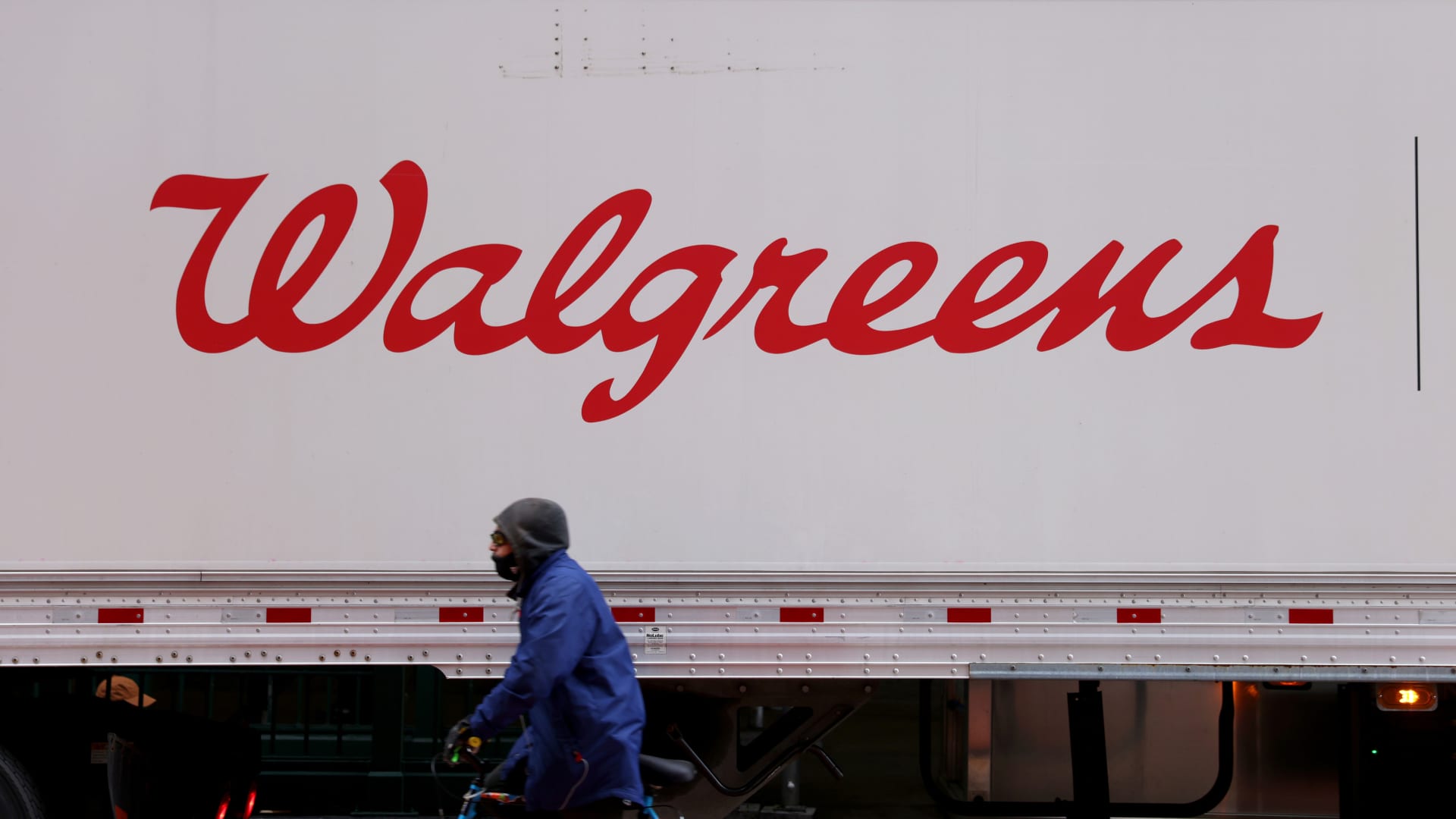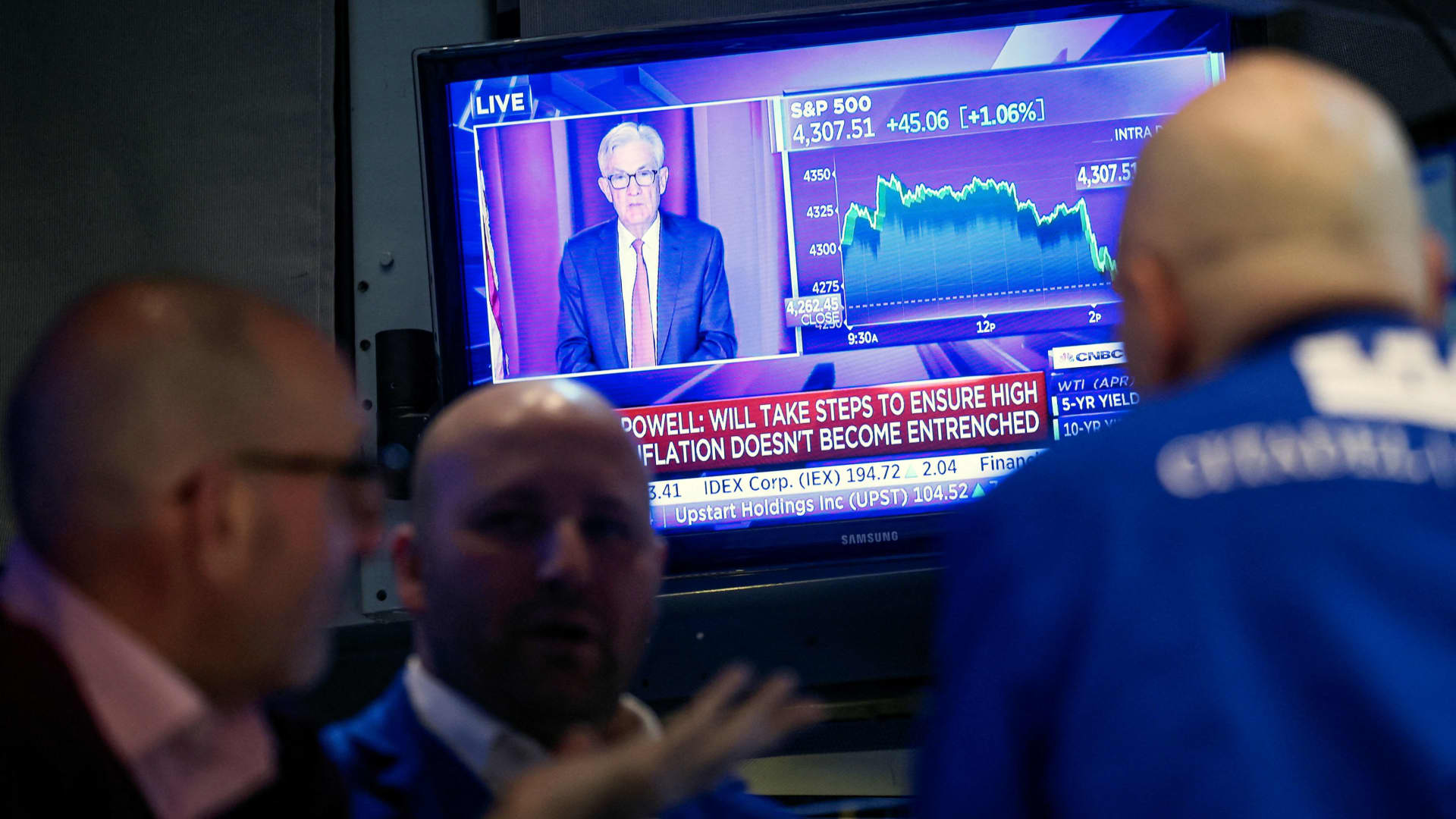
The S&P 500 and the Nasdaq Composite fell for a second straight session in a lackluster start to September.
The S&P 500 lost 0.16% to finish at 5,520.07, while the Nasdaq Composite slipped 0.3% to close at 17,084.30. The Dow Jones Industrial Average was the outlier, edging up 38.04 points, or 0.09%, to end at 40,974.97.
"At least on the margins, you're seeing some nibbling after that sell off yesterday," said Truist's co-chief investment officer Keith Lerner. "Investors are a bit on edge; it's a low-conviction trade. Everyone's waiting for this Friday employment report, and until then, we're in a bit of a holding pattern."
Nvidia fell 1.7% following a Bloomberg report that the U.S. Justice Department sent subpoenas to the chipmaker. The move comes after Nvidia tumbled more than 9% Tuesday amid a broader pullback in semiconductors.
Get top local stories in San Diego delivered to you every morning. Sign up for NBC San Diego's News Headlines newsletter.
Some megacap technology and chip stocks regained their footing Wednesday, with Advanced Micro Devices and Tesla rallying about 3% and 4%, respectively. Meta Platforms, Marvell Technology, Broadcom and Qualcomm edged higher.
Stocks bounced off their lows as the so-called yield curve of the Treasury market momentarily returned to a normal state. The curve had been inverted with the rate on the 10-year note lower than the 2-year yield. This is a common recession signal and had worried investors. On Wednesday, the 10-year yield returned to even with the 2-year yield at one point and briefly went slightly higher.
Wall Street is coming off a losing session, with the major benchmarks posting their worst day going back to the sell-off Aug. 5, as chip names struggled and the latest economic data implied slowing growth for the U.S. economy.
Money Report
Traders are bracing for more volatility in September, with many anticipating a pullback of 5% or more in this historically weak stretch for equities. Pullbacks such as those experienced in recent weeks, however, should not dissuade investors, according to TD Wealth's chief investment strategist Sid Vaidya.
"From our standpoint, this is normal course, short-term volatility," he said. "We wouldn't change any positioning based on the last day and a half."
Nasdaq, S&P 500 close lower
The S&P 500 and Nasdaq Composite finished lower Wednesday.
The broad index lost 0.16% to finish at 5,520.07, while the tech-heavy Nasdaq slipped 0.3% to close at 17,084.30. The Dow Jones Industrial Average edged up 38.04 points, or 0.09%, to end at 40,974.97.
— Samantha Subin
Investors shed stocks at fastest pace since late 2020 last week, BofA says
Investors dumped stocks at their fastest pace since November 2020 in the last week of August, according to Bank of America's client flows data.
The Wall Street firm's clients were net sellers of U.S. equities for a second straight week, offloading $8 billion worth of stocks across large, mid- and small-cap stocks, the data said. Selling was led by institutional investors and hedge funds, while private investors sold stocks for a fourth week in a row.
The S&P 500 eked out a 0.2% gain last week, closing out August with a 2.3% gain.
— Yun Li
Traders unsure what 'bad news' for labor market means for stocks, Krinsky says
The stock market's choppy action on Wednesday after another negative report about the labor market suggests that investors are unsure whether bad economic news is a positive or negative sign for equities, according to BTIG.
"Market is still unsure whether it's trading 'bad news as bad'. The latest JOLTs data showed much less openings than expected (last month also revised lower), so the labor market continues to cool. Yet after the knee-jerk reaction, stocks have found their footing suggesting bad is good again, for now," technical strategist Jonathan Krinsky said in a note to clients.
The confused reaction could be due to uncertainty about the Fed's path of rate cuts, with traders split about how large the expected cut later this month will be, Krinsky said.
— Jesse Pound
ETFs saw unusually high inflows in August, State Street says
Investors continued to jump into exchange-traded funds in August despite market turbulence, according to Matthew Bartolini, head of SPDR Americas research at State Street Global Advisors.
"ETFs took in $73 billion in August, more than double the historical August average (+$32 billion), and now have $610 billion for the year (a record first eight months)," Bartolini said in a note to clients. The historical average consists of the previous five Augusts.
Flows improved later in the month once markets calmed from the Aug. 5 sell-off, and U.S. equity ETFs attracted $38 billion of inflows while international equity funds saw outflows, according to the note.
— Jesse Pound
Zscaler poised for worst session since 2019
Zscaler headed for its worst day in about half a decade after posting weak guidance.
Shares of the cloud security stock tumbled around 19% in Wednesday's session. If that holds through the market close, it will be the stock's worst day since September 2019, when shares dropped 19.4%.
Wednesday's sell-off comes after the company told investors to expect between 62 cents and 63 cents earned per share in the fiscal first quarter. That is under the consensus estimate of 73 cents per share from analysts polled by LSEG.
Zscaler also said full-year earnings per share should come within the range of $2.81 per share to $2.87 per share, below Wall Street's estimate for $3.33 a share.
Shares have plummeted more than 29% in 2024.
— Alex Harring
Six S&P 500 stocks make fresh lows

There were six S&P 500 stocks making fresh lows on Wednesday, including discount retailer Dollar Tree, as well as energy names SLB and Halliburton.
Here is the group:
- Dollar General (DG) trading at lows not seen since October 2017
- Dollar Tree (DLTR) trading at lows not seen since March 2020
- Walgreens Boots Alliance (WBA) trading at lows not seen since September 1996
- APA (APA) trading at lows not seen since December 2021
- SLB trading at lows not seen since October 2022
- Halliburton (HAL) trading at lows not seen since May 2023
On the other hand, 71 S&P 500 names hit fresh 52-week highs, including four Dow components: Coca-Cola, Procter & Gamble, Johnson & Johnson and UnitedHealth Group.
— Sarah Min, Gina Francolla
Fed 'Beige Book' sees growth softening, prices easing and hiring cooling
Economic growth slowed across the country while prices rose "modestly" and employers grew more reluctant to hire and choosier about who they selected for job openings, the Federal Reserve reported Wednesday.
In the central bank's "Beige Book" update, which comes out every seven weeks or so, most of the Fed's 12 districts reported "flat or declining activity." Staffing was "steady overall," though there were "isolated reports" of companies filling only necessary openings while reducing hours, shifts and overall employment levels.
"Employers were more selective with their hires and less likely to expand their workforces, citing concerns about demand and an uncertain economic outlook. Accordingly, candidates faced increasing difficulties and longer times to secure a job," the report stated.
The report also noted that home sales softened while most districts expected economic growth "to remain stable or to improve somewhat."
— Jeff Cox
U.S. Steel slumps on report White House will block takeover deal

Shares of U.S. Steel plummeted 18% following a report from the Washington Post that the White House is readying to block Nippon Steel's takeover deal.
U.S. Steel shareholders approved the $14.9 billion buyout in April.
— Spencer Kimball, Samantha Subin
Lockheed Martin, RTX rally to all-time highs as low-volatility defense stocks gain
Lockheed Martin, the maker of F-35 fighter jets, and RTX Corp., maker of Patriot missile systems, have recently climbed to all-time highs, with Lockheed touching a record $578.73 on Wednesday and RTX a record $123.70 last Friday. Both defense stocks are far less volatile than the wider market, sporting a three-year adjusted beta of 0.59 for Lockheed and 0.69 for RTX.
The iShares U.S. Aerospace & Defense ETF touched an all-time high last Thursday.
Lockheed is higher by 23.6% so far in the third quarter, while RTX has gained 21% since the end of June, trailed by Northrop Grumman at 20.5% and Huntington Ingalls at 12%. The ITA defense exchange-traded fund has advanced 9% so far in the third quarter.
— Scott Schnipper
Markets will be 'choppy' over next two months followed by postelection rise, says Wolfe Research
Investors should buckle up and prepare for some outsized volatility ahead, according to Wolfe Research.
With upcoming U.S. elections in a tight race and September already a historically "weaker seasonal period," the firm expects "much choppier trading over the next two months." But after this tough period, investors should have much to look forward to.
"We see a post-election rip higher with the market broadening out as the Fed cuts rates into slowing inflation while U.S. economic growth remains solid," Wolfe Research wrote.
— Lisa Kailai Han
Dollar Tree heads for worst day since 2001
Dollar Tree shares were poised for their biggest loss in more than two decades after posting disappointing earnings.
Shares tumbled around 20%. If that holds through the closing bell, it will mark the stock's worst day since March 2001, when shares plummeted close to 25%.
The discount retailer posted 97 cents per share in earnings, excluding items, on $7.38 billion in revenue. That is less than the consensus forecasts for $1.04 in earnings per share and $7.49 billion in revenue from analysts surveyed by LSEG.
Shares are down more than 53% in 2024.
— Alex Harring
Stocks making the biggest moves midday

Here are the stocks on the move midday:
- Dollar Tree — Shares tumbled 20% after the discount retailer slashed its full-year outlook for net sales and adjusted earnings per share. Dollar Tree cited increasing pressures on middle- and higher-income customers.
- GitLab — The software developer's stock soared 17% thanks to a strong third-quarter earnings outlook. The company forecasts earnings per share of 15 cents to 16 cents for the period, above the 11 cents that analysts surveyed by LSEG had estimated. GitLab's full-year sales outlook also came in above expectations.
- Zscaler — The stock lost 18% after the cloud security company's fiscal first-quarter earnings outlook came in weaker than expected. Zscaler expects to earn between 62 cents and 63 cents per share, below the 73 cents per share analysts were estimating, per LSEG. The company also expects to earn between $2.81 per share and $2.87 per share for the full year. That is below the analyst estimate of $3.33 per share.
Read the full list here.
— Sean Conlon
Apollo could join S&P 500 this month, Bank of America says
Apollo Global Management is a strong candidate to join the S&P 500, which could create some new demand for the financial stock, according to Bank of America analyst Craig Siegenthaler.
"We still expect that APO will be the next financial services stock added to the S&P 500 and very likely before March '25," Siegenthaler said in a note to clients.
Since the S&P 500 index is closely tracked by many massive index funds, the quarterly rebalance for the index is a major event for stocks that drop out or join. The next quarterly update to the index is schedule to be released at the end of this week, with Sept. 20 as the official rebalance day. Many funds will make their changes on or before that day.
"The actual rebalance/buying from passive funds will occur at market close on Sep 20, and if APO is added, we would expect outperformance from September 6 potentially followed by volatility," the note said.
— Jesse Pound
Traders raise expectations for the Fed to cut by half a point

Traders raised their bets Wednesday that the Federal Reserve will cut benchmark interest rates by half a percentage point later this month, fueled by an unexpected decline in job openings and comments from a key policymaker.
Fed funds futures pricing pointed to about a 50-50 chance of the Fed lowering rates by 50 basis points at its Sept. 17-18 meeting. That was up from about 38% on Tuesday, according to the CME Group's FedWatch gauge.
The move followed a Labor Department report showing that job openings declined to their lowest level since January 2021, and comments from Atlanta Fed President Raphael Bostic, who said the central bank should not want until inflation hits 2% before it starts easing.
— Jeff Cox
UnitedHealth, Goldman Sachs lead Dow higher

The Dow Jones Industrial Average rallied 160 points, or 0.4%, outperforming the major indexes during morning trading.
UnitedHealth and Goldman Sachs were the biggest contributors to the Dow's rally, adding at least 1%. McDonald's and Boeing also lifted the Dow, rising about 1% and 2.6%, respectively. 3M and Travelers edged up about 1% each.
— Samantha Subin
Job openings for July come in well below estimates
The number of U.S. job openings for July came in at 7.7 million, while economists polled by Dow Jones expected 8.1 million. That marks the lowest level for job openings since 2021.
The miss was driven by a decrease of 187,000 openings in the health-care and social assistance sector. State and local government job openings also fell by 101,000, the Bureau of Labor Statistics said.
— Fred Imbert
U.S. crude oil falls below $70 per barrel to trade near nine-month low

U.S. crude oil fell nearly 1% on Wednesday, tumbling below $70 per barrel and raising speculation that OPEC+ could delay production increases scheduled to begin next month.
The U.S. benchmark hit a low of $69.19 earlier in the session, the lowest level since Dec. 13, after plunging more than 4% on Tuesday. U.S. crude and global benchmark Brent have erased all gains for 2024.
"With demand growth uncertain and significant supply outages looking unlikely, all eyes are again on OPEC+," Svetlana Tretyakova, senior analyst at Rystad Energy, said in a note Wednesday. "Until OPEC+ clarifies its strategy, overall bearishness will persist."
— Spencer Kimball
S&P 500 opens lower
The S&P 500 opened 0.4% lower as equities looked to continue a tough start to the month. The Nasdaq Composite shed 0.7%, while the Dow Jones Industrial Average lost 0.1%, or 50 points.
— Samantha Subin
Stocks making the biggest moves premarket

Check out some of the companies making headlines in premarket trading:
- Nvidia — Shares of the artificial intelligence darling pulled back more than 1% following a report from Bloomberg that the U.S. Department of Justice subpoenaed the chip company in concert with a broader antitrust investigation.
- Dick's Sporting Goods — Stock in the retailer fell about 1% despite its second-quarter results surpassing Wall Street estimates. Dick's raised the top end of its full-year earnings forecast, predicting earnings in the range $13.55 to $13.90 per share, compared to a prior estimate of $13.35 to $13.75. Analysts polled by FactSet forecast $13.80 in earnings per share.
- Dollar Tree — Shares plunged nearly 11% after the dollar store missed second-quarter revenue estimates and trimmed its full-year forecast. Dollar Tree estimates adjusted earnings in a range of $5.20 per share to $5.60, compared to a previous estimate that called for $6.50 to $7 per share. Analysts surveyed by FactSet were looking for a profit of $6.56 per share.
Read the full list here.
— Brian Evans
U.S. trade deficit swells as shortfall with China jumps
The U.S. trade imbalance widened to its highest level in more than two years, though it was a touch less than what economists had been expecting.
For July, the deficit expanded to $78.8 billion, up nearly $6 billion from June though less than the $79.1 billion estimate from the Dow Jones consensus, the Census Bureau reported Wednesday. The move came as the goods deficit expanded to $103.1 billion while the services surplus decreased to $24.3 billion.
One reason for the growth in the shortfall was that the deficit with China rose to $27.2 billion, an increase of $4.9 billion, or 22%.
— Jeff Cox
Ed Yardeni says he's rooting for political gridlock

Widely followed strategist Ed Yardeni expects the market to remain choppy heading into the November election, and said what happens after that depends on the outcome.
"I'm rooting for gridlock," the president of Yardeni Research said on CNBC's "Squawk Box" on Wednesday.
"If we get a sweep of the Democrats or a sweep of the Republicans, I don't think the market is going to look forward to those kind of regimes."
Instead, the market prefers gridlock, with one party in the White House and another in charge of Congress, he said.
"I think gridlock will win. If that is the case, I think the market will move higher simply because the economy is doing fine."
— Michelle Fox
Dollar Tree drops on guidance cut, weak second-quarter results
Dollar Tree shed more than 11% before the bell after the discount retailer slashed its guidance as shoppers struggle.
The company cut its guidance for the year, saying it now expects adjusted earnings to range between $5.20 and $5.60 a share and revenue of $30.6 billion to $30.9 billion. Dollar Tree previously said it expected earnings per share to range between $6.50 and $7 and revenue of $31 billion to $32 billion.
Dollar Tree also posted $7.37 billion in revenue for the quarter, falling short of a FactSet estimate of $7.49 billion.
The lackluster results come less than a week after Dollar General tumbled 25% on the heels of a disappointing earnings report and forecast cut. The company blamed "softer sales trends" and a "financially constrained" key customer among the reasons for the disappointing results.
Discount retailers fell in sympathy with Dollar Tree's results, with Dollar General last down more than 2%. Five Below declined 1.7% before the bell.
— Samantha Subin
Tech under pressure again
Tech stocks fell in the premarket Wednesday, putting pressure on equity futures as the sector was primed to add to the steep losses seen in the previous session.
Nvidia shares were down more than 1% along with Tesla. Apple and Broadcom, meanwhile, dipped 0.8% and 0.9%, respectively. The Technology Select Sector SPDR Fund (XLK) shed 0.9% as well.
— Fred Imbert
Nvidia falls 2% after Tuesday's sell-off, semiconductor stocks struggle

Nvidia shares dipped more than 2% before the bell following a Bloomberg report that the chipmaker received a subpoena from the U.S. Department of Justice in relation to an antitrust investigation.
The premarket moves come after the chip giant tumbled nearly 10% during Tuesday's session and cleared nearly $300 billion in market value.
Other chip stocks tumbled before the bell, with Broadcom, Marvell Technology, Qualcomm and Micron Technology last down 1% each. The VanEck Semiconductor ETF lost 1.4%.
— Samantha Subin
Markets are caught in a 'doom loop,' Vital Knowledge says
Adam Crisafulli of Vital Knowledge noted that while economic data Tuesday was not great, there has not been any meaningful change to the market narrative over the past 48 hours.
"Rather than responding to a piece of actual news, markets are instead caught up in a doom loop whereby downside price action creates a narrative of negativity and starts to feed on itself (this is consistent with what happened in early Aug). The lack of valuation support leaves stocks susceptible to these types of sharp slumps, but the absence of a fundamental shift means the drop should be ephemeral," Crisafulli wrote.
— Fred Imbert
Semiconductor ETF suffers worst day since March 2020
The VanEck Semiconductor ETF (SMH) tumbled 7.5% on Tuesday as stocks sold off to start September, led by tech names.
It was the worst session for the chip-focused exchange-traded fund since March 18, 2020, when it fell 8.31%.

Though Nvidia's 9.5% decline dragged the ETF — plus the Nasdaq Composite and S&P 500 — lower, the worst performer in SMH was Monolithic Power Systems with a 10.3% slide.
KLA and ON Semiconductor also suffered, with both dropping more than 9%.
Even as SMH tumbled on Tuesday, the ETF is up nearly 29% in 2024.
— Darla Mercado, Gina Francolla
Economic data set to release Wednesday
A raft of economic data is due out Wednesday morning. Here is what economists are expecting:
- The U.S. trade deficit, which is the difference between U.S. exports and imports, is expected to have widened to $79.1 billion in July, up from $73.11 billion in June, according to Dow Jones consensus estimates. The data is set to release at 8:30 a.m. ET.
- The latest job openings and labor turnover survey, or JOLTS, a measure of the health of the labor market, is expected to show a slight decline in job openings. Economists polled by Dow Jones expect the number of job openings to have fallen to 8.1 million in July, down from 8.2 million in June. The data is due out 10 a.m. ET.
- Factory orders data is set to have jumped sharply in July. The economic indicator that measures the value of goods ordered by factories is forecast to have spiked 5% that month, up from a 3.3% decline the prior period, according to Dow Jones. The indicator is set for release at 10 a.m. ET .
— Sarah Min
Stock futures open little changed
U.S. stock futures opened flat Tuesday night.
Dow Jones Industrial Average futures fell 5 points, or 0.01%. S&P 500 futures and Nasdaq 100 futures dipped 0.05% and 0.04%, respectively.
— Sarah Min






